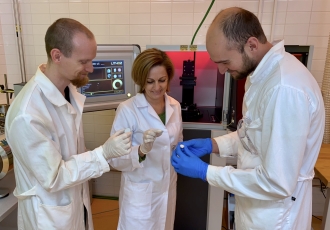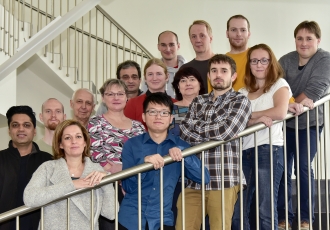31. May 2024
No daylight! No blue light is allowed to enter the lab where ceramic objects are printed using a 3D printer. This is prevented by yellow foils that are stuck to the windows. A room where you can see yellow gives you a warm feeling, but it can also give you a headache. However, the researcher Přemysl Šťastný from the Advanced Ceramic Materials research group at CEITEC BUT has no problem with this, so here he and other colleagues under the leadership of Klára Částková print spinal implants there. 3D printing is not suitable everywhere, however, as Šťastný says, every ceramic technology has its own benefits. 3D printing enables the production of high-tech components with complex shapes that could not be created otherwise. But they’re not exactly cheap.
What makes 3D ceramic printing specific?
Today’s 3D printing offers a wide range of methods, but they all have one thing in common – the objects are created in layers. You gradually print one layer after another until the entire object is created. The methods differ in what the layers are made of. We do 3D printing, where we convert a liquid phase into a solid phase to make individual layers and print ceramics.
What do you print ceramic objects from?
We prepare a mixture that is sensitive to light, especially blue light with a wavelength of 465 nm. This part of visible light is also contained in the light that surrounds us, from the sun. If we had windows without the yellow filter and mixed our mixtures, they would solidify in the beaker, depriving us of the option to print anything. And those mixtures, that’s a combination of monomeric substances to which a photoinitiator is added – a substance that absorbs a photon of visible light, gets energy from it and splits the double-bond molecule. And since there is a double bond that gets split, the molecule suddenly gets “hands” that it can stretch to its partners, and the chaining process begins. And that’s how a liquid becomes a solid.
What does 3D printing bring to the table compared to conventional ways of making ceramics?
When we talk about ceramics, everyone thinks of a plate, a toilet or a sink – and that’s right. The difference between our ceramics and conventional ones is in the purity of raw materials. We use chemically pure raw materials such as alumina, Al2O3. It’s a white powder and you have several options when you want to make a body out of it. If you’ve ever tried to make a mug or something out of pottery clay – you take clay, which is some particles of a mineral, you put it together, you put it in heat and you get a hard mug. In that heat treatment, the individual clay particles solidify and give you a compact whole. This works exactly the same way. In our case, we use pure powder instead of clay and there are dozens of ways of ceramic technology. The very simplest is to take the powder, compress it and bake it into a puck shape. What 3D printing adds is the ability to shape the powder as it’s being made, because standard methods of shaping ceramics are limited to very basic and simple shapes.
Can you describe the 3D printing process for us?
From the bottom of the printer there is a projector, just like the one we use as on the wall, which projects the different layers of the printed object. We can see the layer that is currently being printed on the monitor. The printer applies a thin layer of mixture and then shines light on it, which triggers the molecule-bonding reaction mentioned earlier. This reaction takes a few seconds and produces a solid layer onto which the next layer is applied. The layers are printed upside down, which saves material – if they were printed downwards, the layers would have to be poured from above, which would require much more compound that is expensive. By printing upside down, only a small amount is needed to create the entire body. We are printing a solid now that has a complex shape – it is called a gyroid. When it’s printed, it will be stuck upside down, and we’ll cut it off. It’s good to remember that our 3D printer doesn’t print large objects; it’s always objects on the order of cubic centimetres.
What are the possible applications?
One of the projects that is very important and may affect all of us in the future is focused on human health. We are collaborating with the University Hospital Brno and the Faculty of Medicine to develop implants for implantation into the vertebral space. Titanium implants are used now. But titanium can cause many problems in the form of allergic reactions. In contrast, ceramics can be completely inert, such as Al2O3, or bioactive, such as hydroxyapatite, which is partially resorbed. In a herniated disc, the gel mass that separates the vertebrae from each other is prolapsed. This begins to compress the nerves, causing pain. When physiotherapy does not help, surgery is required to ensure that the vertebrae are separated again. This is done with a titanium wedge or a spacer. We’ve got the same shape, but it’s ceramic.
It looks like a small coffin... You have different shapes here. What’s the difference?
Yes, it may seem like a coffin. Then there’s the banana-shaped body. The shapes depend where in the spine the implants need to be placed. These implants are not made to fit the patient, they are just size sets. Our ceramic implants are not used yet, though. We are now testing their properties to see if they can withstand the implant procedure, where they are basically hammered into the spine. The second thing is that it’s common practice to insert bone marrow, either from the patient or the donor, into the wedge hole. That’s a step we want to avoid. Our goal is to fill it with a porous insert that will also allow the vertebrae to fuse, without the need to remove pulp from another bone.
When I look at the printed bodies, it’s extremely precise work. You can’t even tell they have been printed in layers. How much does it cost?
Exactly. They’re not very bulky, but they are shape intensive. There is no other way to make such parts except for 3D printing. You can’t expect the costs to be particularly low. I can’t say exactly, but for an implant of this type, it would probably be tens of thousands of Czech crowns. So it wouldn’t be worth printing ordinary ceramic grommets; there are other proven and cheaper technologies for that. 3D printing is ideal for modern high-tech parts where you are willing to pay a higher price, even in small numbers, because the added value of these parts is huge.
So, for example, 3D printing teeth would not make sense?
There has been a lot of discussion about this at conferences. At least for me, the outcome was that the current technology is satisfactory and that 3D printing would not get similar prices, and therefore, it doesn’t make much sense. The downside of the current technology is that there is a lot of unused material that remains that cannot be recycled and is thrown away.
What other projects do you use 3D printing for?
We use 3D printing to prepare, for example, discharge tubes for low-temperature plasma discharges, where the plasma discharge burns on the surface of the ceramic. They are used, for example, to sterilize surfaces or to change their wettability. Another use is in the various chemical reactions that take place during the plasma discharge. We are working with Masaryk University to develop substrates suitable for this process. We are also investigating the fabrication of complex optical elements with inhomogeneous structures, which is difficult to achieve with standard ceramic technologies. What appeals to me personally about 3D printing is the ability to create custom designs for components and then print them, rather than just getting a large disk and finding someone who can machine it – as is the case of those dentures.
Could you explain how you prepare the tubes and why?
We’re working with the fact that, at the moment, the tube is actually a ceramic wafer, and on the other side, there are electrodes that have to be encased in some kind of dielectric varnish so that there’s no short circuit between them. And our aim is to get those electrodes inside the ceramic, which is a material junction. So imagine that instead of one tub of compound, you have maybe two side by side, and the head comes in between them and prints different materials into each other, which is a big hit in the 3D printing field right now.
What is your cooperation with the Austrian company Litos, a leading supplier of 3D printing equipment for ceramics?
We are collaborating with them on removing the binder from 3D-printed parts, which is a complex and time-consuming process. We are trying to speed up the production process. That’s kind of the Achilles heel of this technology. You make the mix in the right proportions, and you print the part fairly quickly, but then you have to put it in the oven for a week to gradually heat it up to remove the unwanted binder. This is, of course, annoying because it costs time, and time is money. These days it’s all about making processes faster and simpler, so that’s the kind of thing we collaborate on.
And are you successful?
We’ve been able to reduce a week-long process to two to three days. But, of course, the process is still confidential.
Are students interested in 3D printing ceramics?
I think there’s a lot of interest because I see the power of being able to show them what we can print from it. It’s not just a puck. And I think that’s appealing to today’s students because they way I see it, today’s students want to see results. I think everybody likes to print something that they could actually use somewhere. We have some students here with interesting thesis topics. There are lots of ideas; sometimes, we have to make them slow down a little (laughs).


 Share
Share




